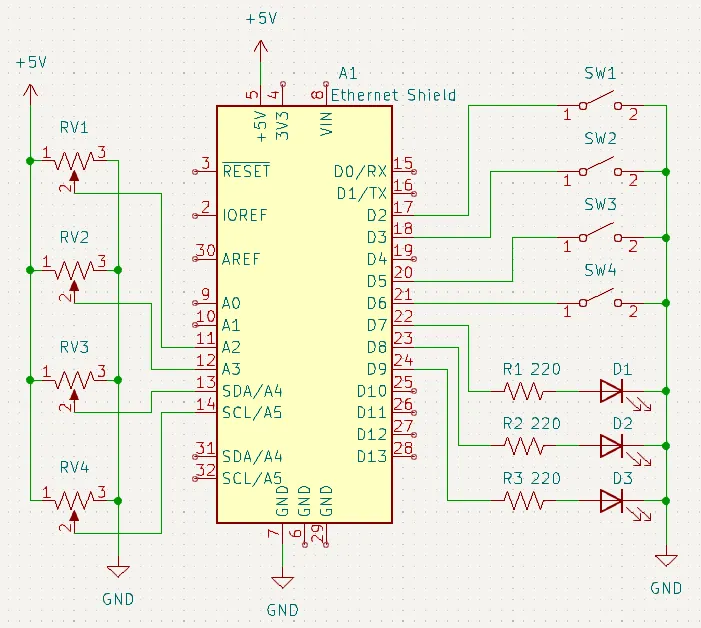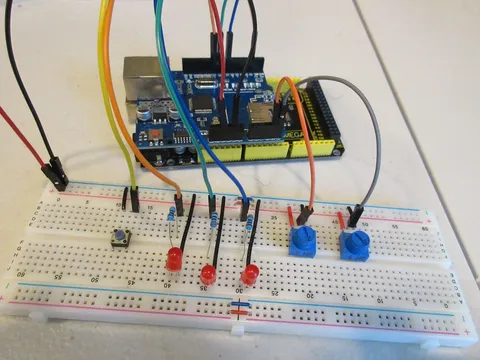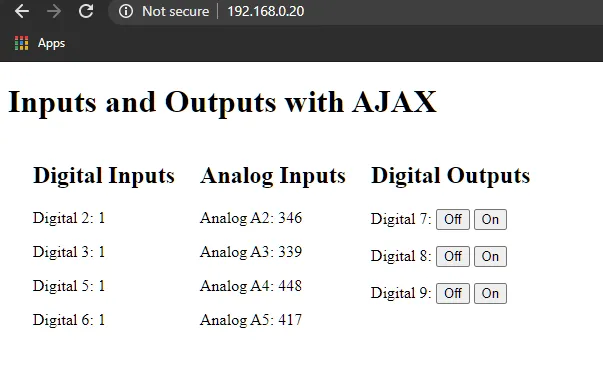
Ethernet I/O Controller with Arduino

Published
Creating a web page with the Arduino and Ethernet shield to control I/O pins
Overview
This project uses a web server page to control the Arduino’s I/O ports remotely. See Ethernet Shield for more details on using the Ethernet shield and its SD card slot with Arduino.
Warning | An Arduino Uno may not have enough memory for this program. You can use any board with sufficient memory, such as a Mega. |
Schematic

HTML File
Save this HTML file as index.htm in your SD card:
<!DOCTYPE html>
<html>
<head>
<title>Arduino Web Server</title>
<script>
var outputStates = [0, 0, 0];
function setOutput(num, state) {
outputStates[num] = state;
var reqString = "outputs";
for (var i = 0; i < outputStates.length; i++) {
reqString += "&out" + i.toString() + "=" + outputStates[i];
}
var nocache = "&nocache=" + Math.random() * 1000000;
var request = new XMLHttpRequest();
reqString += nocache;
request.open("GET", reqString, true);
request.send(null);
}
function getInputs() {
var nocache = "&nocache=" + Math.random() * 1000000;
var request = new XMLHttpRequest();
request.onreadystatechange = function () {
if ((this.readyState == 4) && (this.status == 200) && (this.responseXML != null)) {
// Get the states of digital and analog pins
var digitalStates = this.responseXML.getElementsByTagName("digital");
var analogStates = this.responseXML.getElementsByTagName("analog");
// Get the number of digital and analog pins
var numDigital = digitalStates.length;
var numAnalog = analogStates.length;
// Update the states with the new data
for (var i = 0; i < numDigital; i++) {
document.getElementsByClassName("digital")[i].innerHTML = digitalStates[i].childNodes[0].nodeValue;
}
for (var i = 0; i < numAnalog; i++) {
document.getElementsByClassName("analog")[i].innerHTML = analogStates[i].childNodes[0].nodeValue;
}
}
}
request.open("GET", "inputs" + nocache, true);
request.send(null);
}
setInterval(getInputs, 250);
</script>
<style>
.io-container {
float: left;
margin-left: 25px;
}
.heading {
text-align: center;
}
</style>
</head>
<body>
<h1>Inputs and Outputs with AJAX</h1>
<div class="io-container">
<h2 class="heading">Digital Inputs</h2>
<p>Digital 2: <span class="digital">Not loaded</span></p>
<p>Digital 3: <span class="digital">Not loaded</span></p>
<p>Digital 5: <span class="digital">Not loaded</span></p>
<p>Digital 6: <span class="digital">Not loaded</span></p>
</div>
<div class="io-container">
<h2 class="heading">Analog Inputs</h2>
<p>Analog A2: <span class="analog">Not loaded</span></p>
<p>Analog A3: <span class="analog">Not loaded</span></p>
<p>Analog A4: <span class="analog">Not loaded</span></p>
<p>Analog A5: <span class="analog">Not loaded</span></p>
</div>
<div class="io-container">
<h2 class="heading">Digital Outputs</h2>
<p>Digital 7: <button onclick="setOutput(0, 0)">Off</button> <button onclick="setOutput(0, 1)">On</button></p>
<p>Digital 8: <button onclick="setOutput(1, 0)">Off</button> <button onclick="setOutput(1, 1)">On</button></p>
<p>Digital 9: <button onclick="setOutput(2, 0)">Off</button> <button onclick="setOutput(2, 1)">On</button></p>
</div>
</body>
</html>This HTML page is similar to the last example in the "Ethernet Shield" article. There are not many changes to the HTML/JS code. This is because we used many loops to iterate through the pins, so the request handling code can be left alone. However, there are more tags that show the input states, since we have more inputs. We have also used <div> tags, which are used to style a group of elements.
We have also used internal CSS in the <style> tag. The float: left; means that the element should go as far left as possible in its container and margin-left: 25px; means that there should be a 25px wide margin to the left of the element.
Arduino Code
#include <SPI.h>
#include <Ethernet.h>
#include <SD.h>
// MAC address (dependent on your network)
byte mac[] = {0xDE, 0xAD, 0xBE, 0xEF, 0xFE, 0xED};
IPAddress ip(192, 168, 0, 20); // IP address is 192.168.0.20
EthernetServer server(80); // Port 80 is default for HTTP
const int requestLen = 35; // Size of HTTP request array
char request[requestLen]; // HTTP request stored in char array to save memory
int reqIdx = 0; // Current index of request
int inputPins[] = {2, 3, 5, 6}; // Digital input pins used
int numDigital = sizeof(inputPins) / sizeof(int); // The number of digital input pins used
int analogPins[] = {A2, A3, A4, A5}; // Analog input pins used
int numAnalog = sizeof(analogPins) / sizeof(int); // The number of analog input pins used
int outputPins[] = {7, 8, 9}; // Digital output pins used
int numOutputs = sizeof(outputPins) / sizeof(int); // The number of digital output pins used
void setup() {
Serial.begin(9600); // Open a serial port
Serial.println("Ethernet Web Server");
// -------------- SD Card init start --------------
// Disable Ethernet chip while SD card is being initialized
pinMode(10, OUTPUT);
digitalWrite(10, HIGH);
Serial.print("Initializing SD card... ");
if (!SD.begin(4)) {
Serial.println("Failed.");
return;
}
Serial.println("Done.");
// Check if index.htm exists
Serial.print("Looking for index.htm... ");
if (!SD.exists("index.htm")) {
Serial.println("Failed.");
}
Serial.println("Done.");
// -------------- SD Card init end --------------
// -------------- Ethernet init start --------------
Ethernet.begin(mac, ip); // Start Ethernet connection with IP and MAC
if (Ethernet.hardwareStatus() == EthernetNoHardware) {
// The Ethernet shield is not attached
Serial.println("Ethernet shield was not found");
return; // Do nothing
}
if (Ethernet.linkStatus() == LinkOFF) {
// Ethernet cable is not connected
Serial.println("Ethernet cable is not connected.");
}
// Start the server
server.begin();
// Print the IP address
Serial.print("Server is at: ");
Serial.println(Ethernet.localIP());
// -------------- Ethernet init end --------------
// Configure digital input pins as input pullup
for (int i = 0; i < numDigital; i++) {
pinMode(inputPins[i], INPUT_PULLUP);
}
// Configure digital output pins as output
for (int i = 0; i < numOutputs; i++) {
pinMode(outputPins[i], OUTPUT);
}
}
void loop() {
// Listen for incoming clients
EthernetClient client = server.available();
if (client) {
// New client
// HTTP requests end with a blank line
bool currentLineIsBlank = true;
while (client.connected()) {
if (client.available()) {
char c = client.read();
if (reqIdx < requestLen) request[reqIdx] = c; // Append c to the request
reqIdx++;
// if you've gotten to the end of the line (received a newline
// character) and the line is blank, the http request has ended,
// so you can send a reply
if (c == '\n' && currentLineIsBlank) {
// Send HTTP resonse header
if (contains(request, "GET /inputs")) {
// Send inputs in XML file
client.println("HTTP/1.1 200 OK");
client.println("Content-Type: text/xml");
client.println("Connection: close");
client.println();
sendXML(client); // Send XML data to client
} else if (contains(request, "GET /outputs")) {
if (contains(request, "out0=0")) digitalWrite(outputPins[0], LOW);
else if (contains(request, "out0=1")) digitalWrite(outputPins[0], HIGH);
if (contains(request, "out1=0")) digitalWrite(outputPins[1], LOW);
else if (contains(request, "out1=1")) digitalWrite(outputPins[1], HIGH);
if (contains(request, "out2=0")) digitalWrite(outputPins[2], LOW);
else if (contains(request, "out2=1")) digitalWrite(outputPins[2], HIGH);
} else {
// Request to index.htm
// Open HTM file
File f; // File to read from SD
f = SD.open("index.htm");
// Send HTML to client
if (f) {
client.println("HTTP/1.1 200 OK");
client.println("Content-Type: text/html");
client.println("Connection: close");
client.println();
while (f.available()) {
client.write(f.read());
}
f.close();
} else {
// Unable to open file
client.println("Unable to open file");
}
}
// Clear request and break
clearRequest();
break;
}
if (c == '\n') {
// New line
currentLineIsBlank = true;
} else if (c != '\r') {
// Character on current line
currentLineIsBlank = false;
}
}
}
// give the web browser time to receive the data
delay(1);
// close the connection:
client.stop();
}
}
// Clear all elements of the request array
void clearRequest() {
for (int i = 0; i < requestLen; i++) request[i] = 0;
reqIdx = 0; // Reset index to 0
}
// Check if string2 is in string1
bool contains(char* string1, char* string2) {
int found = 0;
int len = strlen(string1);
if (strlen(string2) > len) return false;
for (int i = 0; i < len; i++) {
if (string1[i] == string2[found]) {
found++;
if (strlen(string2) == found) return true;
}
else found = 0;
}
return false;
}
// Send XML to client containing input data
void sendXML(EthernetClient client) {
// Send XML data
client.println("<?xml version='1.0' encoding='UTF-8'?>");
client.println("<inputs>");
// Read and send digital pin states
for (int i = 0; i < numDigital; i++) {
client.print("<digital>");
client.print(digitalRead(inputPins[i]));
client.println("</digital>");
}
// Read and send analog pin states
for (int i = 0; i < numAnalog; i++) {
client.print("<analog>");
client.print(analogRead(analogPins[i]));
client.println("</analog>");
}
client.println("</inputs>");
}Running the Code
Follow the same steps as in "Ethernet Shield". However, you should see a different page:

This page contains three columns: one for digital inputs, one for analog inputs, and one for digital outputs.
The first two columns contain the states of digital and analog inputs, respectively.
The last column allows you to control the three digital outputs.